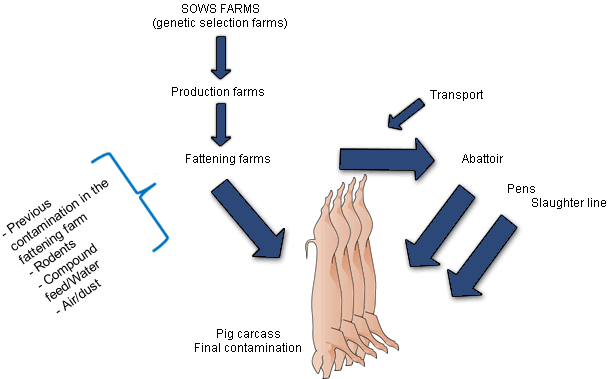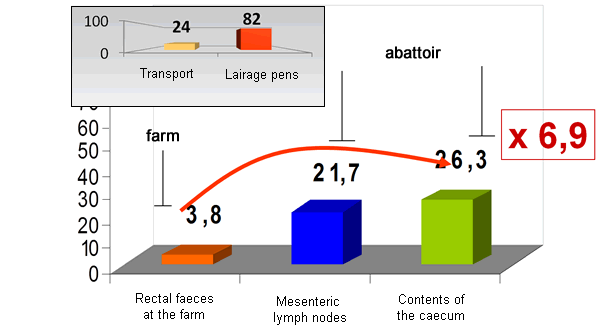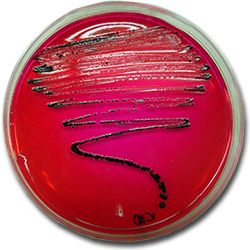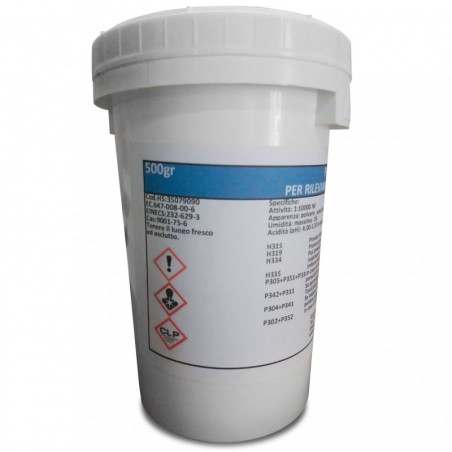Why should we control swine salmonellosis ?
|
 Isolation of Salmonella in XLD. In this culture medium the Salmonella colonies grow with a black colour due to the production of hydrogen sulphide. |
Pork is considered one of the main sources of human salmonellosis. The success of the control programs in poultry farming has increased the relative percentage of salmonella infections caused by the consumption of pork. Coupled to this, the fact that exporting countries in the EU as, for instance, Denmark, Germany or The Netherlands, include national control programmes, increases the pressure in order that the meat exporters are Salmonella-free. Due to both aforementioned reasons and to the basis established in the European Union Regulation 2160/2003 in which the guidelines for the implementation of compulsory programmes for the control of Salmonella in swine are established, the control of this pathogen in this sector is essential. This article concentrates on the role played by the abattoir in the final contamination of the meat for a better understanding of the critical points of the spreading of the pathogen and for the implementation of possible actions/measures. In the next two articles we will try to explain the role that the abattoir and the butchering room can play in the spreading of Salmonella, as well as the importance of the processes prior to the slaughter in the transmission and the spreading of Salmonella between animals and in the final contamination of the carcass.
Where are the control measures most effective ?
If we want to establish effective measures for reducing the risk of the transmission of Salmonella in the food chain, these must be applied in those of its points after which the risk of recontamination is not high. It has been sufficiently demonstrated that the risk of contamination by Salmonella increases along the food chain, reaching its maximum in the abattoir (figure 1). So, it seems evident that the abattoir is one of the points in which the actions/measures carried out can be most effective.

Figure 1. Influence of the different production stages on the contamination in the
following stage and on the final contamination of the carcass.
What is the importance of the production stages previous to the slaughter ?
Before referring to what happens in the abattoir, it is necessary to talk briefly about the impact that the fattening farms and the transport have on the contamination of the pigs and the carcasses. The role of the farm is controversial. In the scientific bibliography we can find studies that attribute a 70% of the contamination of the carcasses to the farm where the animals come from, whilst other papers have gotten to demonstrate that even a 100% of the contaminated carcasses in the abattoir were due to the crossed contamination in the slaughter house. From our point of view, the importance of the farm is relative, and even though it depends on various factors, maybe the main decisive factor is the prevalence in the country where that farm is located and, more specifically on the prevalence in the farms or in the producing companies that slaughter pigs in the same abattoir. In this way, in countries with a low prevalence, as in the case of Denmark, where the contamination in the farms is low and the amount of Salmonellas that arrive to the abattoir is limited, the farm factor has a much higher relevance than in countries with a medium or a high prevalence, as in Spain, where it must be borne in mind that, approximately, a third part of the fattening farms has a medium-high contamination due to Salmonellas. In these cases, the contamination in the stages that come after the farm (transport and abattoir) is higher and, as a consequence, those pigs that come from farms that are Salmonella-free have a higher probability of infection or of a crossed-contamination in the carcass.
In a study carried out in 2005, in which we made a monitoring of pigs from the farm to the abattoir, we checked how the final contamination of the carcass in the abattoir was 7 times higher than that found in the farm (figure 2). In this same study, a 50% of the carcasses contaminated by Salmonella were due to crossed contaminations.
% of positive pigs at the farm and at the abattoir

Figure 2. Results of the monitoring study from the farm to the abattoir.
The transportation from the farm to the abattoir is a critical point in the control of swine salmonellosis. On one hand, in the pigs that are carries of the bacterium, the shedding of salmonella in the faeces is favoured by the disorders in the intestinal flora caused by the fasting and the stress caused by the transportation. On the other hand, the lorries normally have a high contamination due to Salmonella, because the usual cleaning and disinfection protocols are not sufficiently effective due to the presence of remains of organic matter and to the formation of biofilms. So, the lorry can be a source of contamination for pigs free of Salmonella or a source of new infections due to other serovars for those pigs that were already contaminated.

What is the role of the abattoir ?
The abattoir is a key point in which the pigs can become infected by Salmonella in the lairage pens, and the infected pigs can spread the salmonellas to the carcasses and the meat in different locations in the slaughter line. At the same time, the abattoir can be the best control tool.






